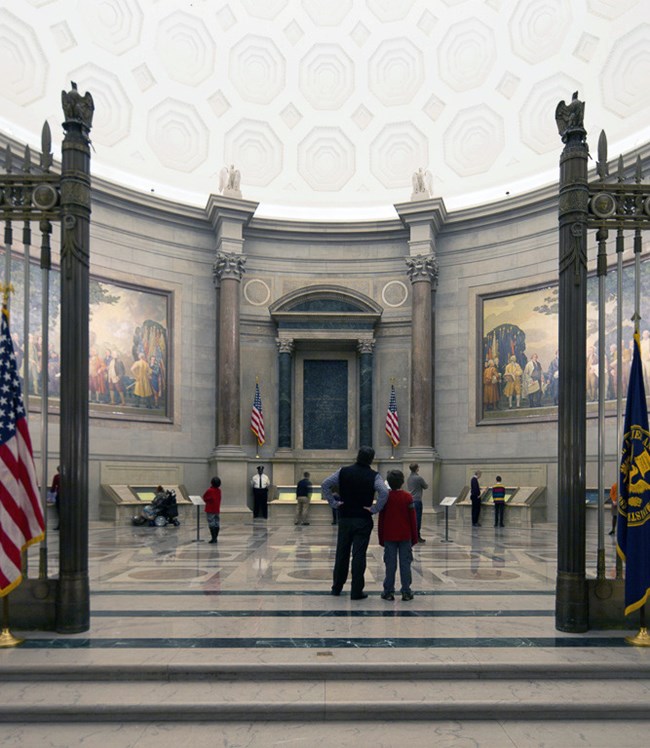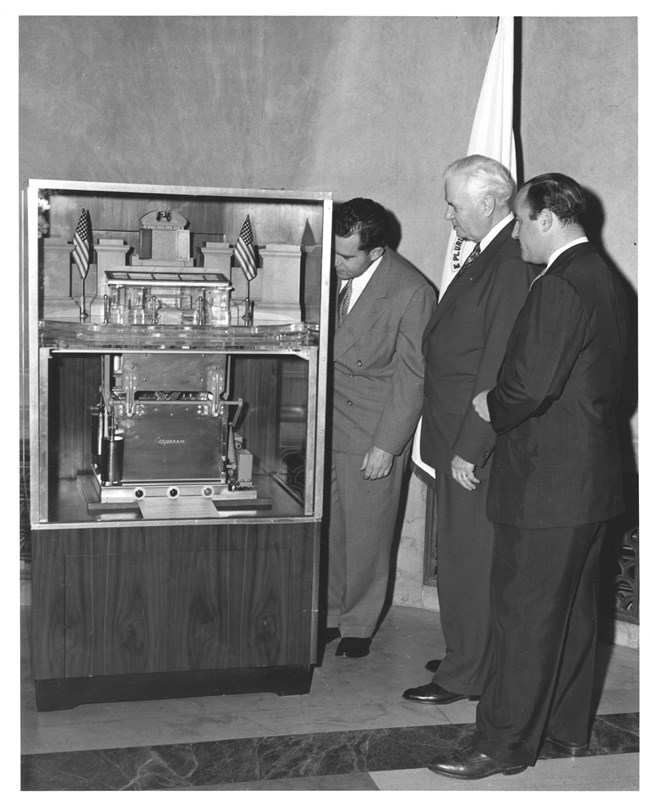Part of a series of articles titled The National Archives as a National Historic Landmark.
Previous: John Russell Pope: Architect
Article

NPS Photo
Prior to their move to the National Archives in 1952, the US Constitution, Declaration of Independence, and Bill of Rights, collectively referred to as the Charters of Freedom, were controlled by the State Department. The documents were displayed at the Centennial Exhibition in 1876 in Philadelphia, and afterwards were returned to the State, War, and Navy Building in Washington, DC (now the Eisenhower Executive Office Building). The documents remained displayed in a cabinet within the departmental library until 1894, when they were removed because they were fading.
The documents remained in storage until 1920, when the Secretary of State formed a committee to advocate for their preservation and exhibition. The committee recommended that the papers of the Continental Congress, as well as other historical archives and papers held at the State Department be transferred to the Library of Congress. In September of 1921, President Warren G. Harding issued an executive order directing the transfer of the Charters of Freedom and other associated founding documents to the Library of Congress.
In 1930, designers for the National Archives added an exhibition hall to their plans. The intention was to create a monumental exhibit space for the nation’s most important founding documents, the Chaters of Freedom. In 1933, President Herbert Hoover announced that the Declaration of Independence and the Constitution would be exhibited at the National Archives building. Later that same year, the building’s architect, John Russell Pope, commissioned artist Barry Faulkner to paint two large murals above the exhibit cases within the archives’ rotunda (known as Exhibition Hall). These murals show the historical events surrounding the creation of the Declaration of Independence and the Constitution, further emphasizing the intention to house and display the Charters of Freedom at the new National Archives.
In October 1934, as the Archives building was nearing completion, President Franklin D. Roosevelt told the first archivist of the United States, Robert Connor, that he thought that the Charters of Freedom and other important historic documents should be housed in the National Archives. However, the Library of Congress objected to the transfer, citing Harding’s Executive Order and the statutory authority of Congress. More attempts were made to move the Charters of Freedom to the Archives, but each was met with objections from the Librarian of Congress, Herbert Putnam, who believed few people would ever go inside the Archives building.

NATIONAL ARCHIVES / NAID: 74227953
It was not until Putnam retired in 1939 and was replaced by Archibald MacLeish that support for the transfer of the Charters of Freedom was revived. In MacLeish’s view, the documents were not important as manuscripts, but rather as objects for display. Despite this shift in perspective, nothing was moved.
Shortly after the bombing of Pearl Harbor in December 1941, the Chaters of Freedom were transferred to Fort Knox for safekeeping and returned to the Library of Congress in 1944. In 1951 the Library of Congress tried to provide better protection for the Charters of Freedom by creating helium-filled cases to protect them from environmental damage.
Though every president from Herbert Hoover through Harry Truman supported the transfer of the founding documents to the National Archives it wasn’t until 1952 that the Archivist of the US, Wayne Grover, succeeded in having them transferred. Grover convinced the Librarian of Congress, Congress, and the President that the nation’s most valuable documents were vulnerable at the Library of Congress, and that the documents were most appropriately classified as federal records, and thus must be transferred to the safer Archives building.
Grover illustrated that that there was little protection against fire or bomb attacks at the Library of Congress and there were also no temperature controls in the library, causing the parchments to continually expand and contract, causing damage. In contrast, the National Archives Building’s exhibition hall was specifically designed to house the precious documents in a climate-controlled space. Grover pointed out that the Public Buildings Service, a department dedicated to maintaining federal buildings, rated the National Archives Building as the safest in the Washington area.
In 1952 the Librarian of Congress agreed that the Charters of Freedom should go to the National Archives, but he insisted that Congress and President Truman needed to approve the move. In response, Grover pointed out that the records of the Continental Congress and the Constitutional Convention had never been in the custody of the Congress as established in 1789, that they were federal records subject to the Federal Records Act of 1950, and that the Archives could force the transfer through regulation. Truman approved the transfer immediately, and Evans sought approval from Congress, which agreed to the transfer on April 30, 1952.
On December 13, 1952, the Charters of Freedom traveled to the Archives in a procession of tanks in an armored personnel carrier. Upon arrival, the documents were placed in a custom-built, 50 ton, steel and concrete, bomb-and fire-proof safe built by the Mosler Safe Company. The safe included a specially designed elevator that allowed the documents to be stored in a fire-, shock-, water-, theft-, and bomb-proof vault at night and then raised into their display cases during the day. Later in June, the remaining records of the Continental Congress and the Constitutional Convention were moved to the National Archives Building. The National Archives then held all the key documents of the nation’s founding, and the building became one of the most popular places to visit in Washington, DC.

NATIONAL ARCHIVES / NAID: 74228153
Bedford, Steven. National Archvies Building. National Historic Landmark nomination form. Washington, DC: US Department of the Interior, National Park Service, 2022.
Part of a series of articles titled The National Archives as a National Historic Landmark.
Previous: John Russell Pope: Architect
Last updated: October 10, 2024